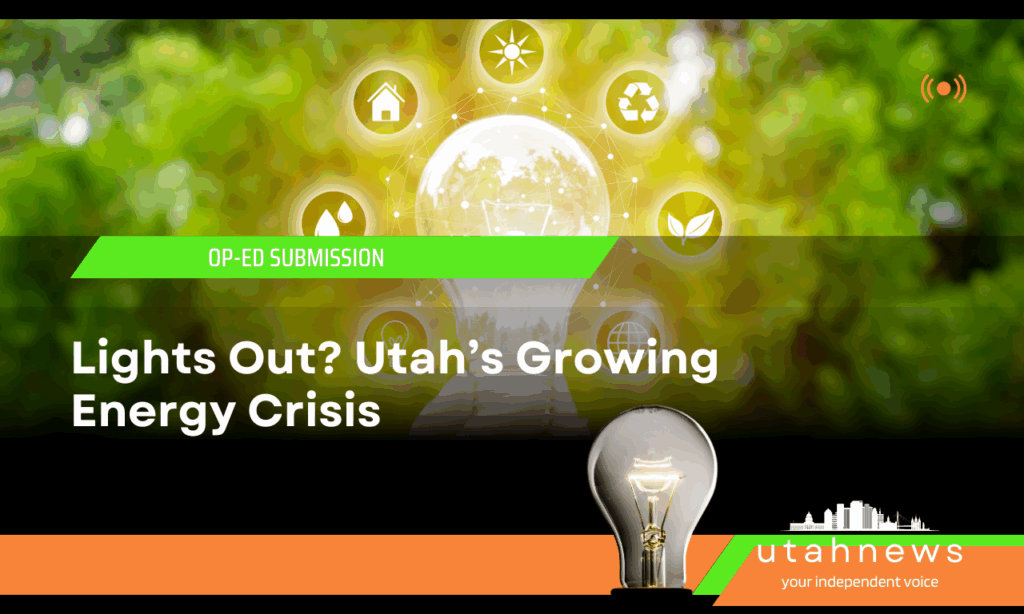If you’re like me you tend to ignore, intentionally or not, the articles that mention broad subjects. An article about something in my city and near to me catches my attention, but large ambiguous things tend to limp off into my peripheral.
That was until recently. I have always assumed — presumptuous I know — that Utah would always be reliable and affordable in energy. I have often felt bad for places like California, Louisiana, even Texas and their energy situations. That time has come and gone, because Utah is now having brownouts. I figured it was about time for me to find out what the deal was. I was a bit shocked by what I discovered.
I thought what better than an article highlighting a few of my surprises.
First off, energy is considered critical infrastructure, and rightfully so. Think about a freezing winter here in Utah and no access to energy. That would be a deadly outcome for some. Energy powers society. It’s also what many say make or break an economy.
Knowing all of that, it is no surprise then that energy is also a target for overzealous entrepreneurs, governments (our own or foreign) and more — some with good intent and some with bad.
Utah’s energy history is long and involved. Former Governor Mike Leavitt was very involved with the clean air movement in Utah and — as you can imagine — coal plants were in the line of fire. I won’t go into that as much because it moved rather slowly, comparatively. I am instead going to start with a quick question about Rocky Mountain Powers agreement to “Net Zero” with “The Point,” and a quote:
“In 2008, Utah enacted a voluntary renewable portfolio goal of 20% renewable energy by 2025. As of 2023, 15.5% of electricity generated in the state was renewable.” source
Before I get into the meat I want to just give a quick timeline of coal plant closures:
- The Carbon Power Plant in Helper, which was the oldest coal-fired power plant in Utah, closed in 2015 due to federal mercury regulations.
- The Desert Power Plant in Tooele County closed in 2008.
- The Hale Power Plant in Orem closed in 1990.
- Multiple units at the Kennecott Power Plant in Salt Lake County closed in 2016 and 2019.
The few that remain open appear to ALL have a closure date but one:

Sources- Bonanza, Hunter, Huntington, Intermountain (something to note here: The Intermountain Power Agency planned to build the third unit of 900 MW capacity. This unit was expected to go online in 2012; however, the project was cancelled after its major purchaser, the city of Los Angeles, decided to become coal-free by 2020.) Even more odd is this link to an article that has been wiped from the wayback machine. More on the history here and Colmac Sunnyside.
It is interesting to note that outside of Hale and technically Kennecott (although we suspect it was being planned all the way back then), they started to close during Obama’s term which is noted for being anti-coal.
“Since his election, the president has tried at every turn to make that goal a reality — ardently supporting a cap-and-trade national energy tax and imposing onerous regulations on coal production. The president and his administration are waging a war on coal.”
Kennecott closed two of theirs as mentioned above in 2016 and 2019. This appears to be from planned closures, likely well before their closure dates.
“All three units were slated for closure before the Jan. 1, 2018, deadline required by the state’s small-particulate implementation plan.” Source- SLTrib“Completing a shift to renewable energy, Kennecott Utah Copper will shut down its last coal-fired power plant in Magna, shrinking its carbon footprint by as much as 65% — a total of more than 1 million tons of carbon dioxide a year, according to its owners.” Source-SLTrib
So, it’s safe to say things like the Paris Agreement (2015), Green New Deal (arguably 2007/2008), and the United Nations SD goals- number 7 to be specific (implementation process 2015/ agenda 1992) were pivotal in the shift towards “renewable energy.”
Utah and the “Renewable Energy” Push
In 2010, former Governor Herbert (governor at the time) announced his intent to create the Utah Energy Initiative. It was a 10-year strategic energy plan. As Utah often does, they created a task force, who relied on stakeholders both public and private. Remember what I said about the push really starting well before Obama, mostly under Leavitt for Utah? Well, here you can see that a bit. Several of the BIG, green energy policy implementations were under Obama in 2015, but the movement was really Gore/Clinton era. Herberts plan was a bit ahead of many others at the time, at least from what I could find.
It is important to note, there have been several green groups pushing policy in Utah that unfortunately only consider the green NGO’s point of view/agenda and sadly, did/do not consider critical things such as:
- Reliable
- Affordable
- Efficient
- TRULY clean
Coal is 3 out of the 4 with at least 80% or higher, and I would almost argue all 4. TRULY clean is listed because coal in Utah is pretty clean. Unlike its solar and wind brothers and sisters, it does not create massive heat islands, recycling environmental issues (coal ash actually can be useful), lithium mining (excessively), and can power far more of the grid on its own than either solar or wind can.
Because critical questions weren’t raised or maybe not heard, the green NGOs prevailed. Utah has since gradually suffered a loss of efficiency and reliability: affordability is becoming increasingly difficult. So much so a group protested Rocky Mountain Powers proposed rate hikes.
It was quite interesting when I went to research for this article submission, so many articles from mainstream outlets blame aging infrastructure, a slow adoption of a full scale “renewable energy” system, and other issues while never acknowledging shutting down coal plants may be a large part of the now struggling grid.
Representative Colin Jack brought a bit of honest perspective to this matter:
“Lawmakers say federal policies and political pressure are helping to turn the lights off in the West and in Utah, with the state facing the very real possibility of rolling blackouts.
Rep. Colin Jack, R-St. George, pointed out that the National Energy Reliability Corp. classifies a huge swath of the West as “Code Orange,” meaning the region is at elevated risk of not being able to meet energy demands.
“What we want to avoid here in Utah is repeating the same mistakes other states have done, which is to demolish our reliable, affordable generating resources and replace them with intermittent and expensive resources that work 20% of the time,” Jack told the Deseret News.”
The federal government’s interest in Utah has been there since before our statehood. Until more recent years however, it was not quite so overreaching.
Utah has a few big deals that the public may not be aware of:
FORGE: “Frontier Observatory for Research in Geothermal Energy (FORGE) initiative is a dedicated field site in Milford, Utah, where scientists and engineers can develop, test, and accelerate breakthroughs in enhanced geothermal systems (EGS) technologies and techniques.” And “…the Utah FORGE project area is rural, covering less than five square miles, and is situated near the town of Milford in Beaver County, Utah’s Renewable Energy Corridor. This part of the Milford Valley hosts a wind farm, solar photovoltaic plant, a geothermal plant, and several hog farms from which biogas is harvested.”

Something to note about geothermal is the danger of earthquakes.
“At a long-term geothermal project in northern California known as the Geysers, the USGS has been monitoring seismic activity since 1975. Even though the area does not appear to have any large faults running through it, we record about 4,000 quakes above magnitude 1.0 every year. We know they result from steam withdrawal or injection because when operators begin geothermal production in a new area, earthquakes begin and when production ends, the earthquakes stop.” source
“On a November afternoon in 2017, a magnitude 5.5 earthquake shook Pohang, South Korea, injuring dozens and forcing more than 1,700 of the city’s residents into emergency housing. Research now shows that development of a geothermal energy project shoulders the blame.” source
You can read more here, you may want to note it says it’s worse if there is a fault line near by.
Nvidia: “To meet global demands, energy companies are turning to a software-defined approach to explore, produce, transport, and deliver lower-cost energy while pursuing net-zero emission goals. They’re leveraging AI and high-performance computing (HPC) to reduce environmental impact from subsurface operations, automate manually intensive surface operations, and bring real-time intelligence to the grid edge.” Utah has signed a major agreement with them.
Green River Energy Center: “…a Utah company to build one of the country’s largest solar and storage facilities in the east-central portion of the state.”
Cape Station Geothermal Project: “Located in Beaver County, this multi-phase geothermal plant will utilize advanced geothermal systems (AGS) and is anticipated to generate significant clean energy, with the first phase expected to be operational by 2026 and the second phase by 2028.” This project is linked to Fervo and Bill Gates. Specifically, current Senator John Curtis, who promotes clean energy and renewable energy programs, is a big supporter of this.
“The Utah senator met with the billionaire philanthropist at a geothermal site in the Beehive State to support clean energy projects — even while they are at risk in Congress.” source
Something interesting to note specifically here is that Curtis and Gates allegedly have a bit of funding history.
ACES Clean Energy Storage project in Delta, Utah: Quote directly from Aces Delta website: “The world is on a mission to become carbon-neutral by 2050. At ACES Delta, we’re moving the boundaries of renewable energy. Enabling previously unattainable utility and industrial scale storage of renewable energy, we are transforming intermittent renewables into reliable, safe, and affordable energy. With ACES Delta, the energy possibilities are limitless.” Wow, that sounds fabulous, right? It does need water but it appears the pro-renewable energy groups are pushing the conservation part mostly onto the farmers. “While the water usage numbers might seem high, they are generally comparable to or lower than other water-intensive industries like agriculture, particularly certain crops like almonds or beef, which require substantially more water per kilogram than hydrogen production.” source
It also appears we might have California involved here:
“The first project, designed to convert and store up to 100 metric tons per day of hydrogen, is under construction and is expected to enter commercial-scale operations in mid-2025 to support the Intermountain Power Project’s “IPP Renewed” initiative.”
NOVVA – With a $2 billion dollar investment Utah has brought in yet another data center. This one has ties to JP Morgan and Starwood Property Trust. “Our accessible, sustainable, safe, and secure Utah data center is located near Salt Lake City in West Jordan, UT. Our flagship hyper-scale data center is the largest data center in Utah, spanning 100 acres with 1.5 million square feet of purpose-built data center space sustainably designed to provide high-density, adaptable data infrastructure for your business.”
The above list is not ALL of the projects by any means, but it is some of the larger ones.
Utah has made some bold moves to completely change one of our most critical infrastructures. It has moved towards renewable energy, possibly too fast and without acknowledging massive pitfalls, like what has happened to Germany and other countries who did the same. The state has also installed smart meters on energy and water, who owns the software? Where were the parts made? Who is Rocky Mountain Power in contract with on meters? Are there any foreign companies involved? Do you like this possible solution from our legislature around the use of energy required by AI data centers moving here? You can also read more about Rocky Mountain Powers vision here.
It would seem to me the biggest mistake a country or state could make is entering into contracts with companies or organizations to manage their most critical needs that are in business with other countries, especially hostile ones in regard to those specific needs. I certainly hope Utah has done its due diligence about these meters, large energy and water projects, and other public-private partnerships.
Hopefully, that helps shed some light on Utah’s energy path. Do you think it’s the right one or the wrong one, or are you undecided? Let us know in the comments.

